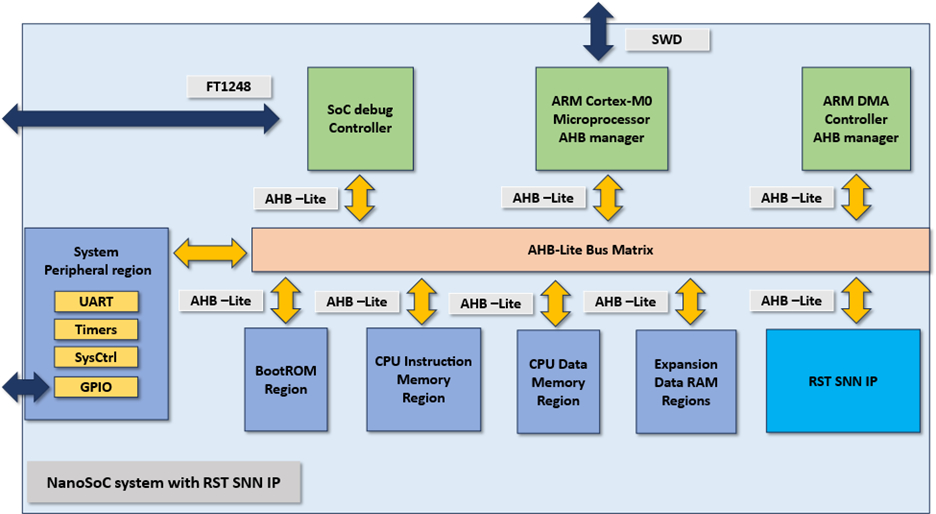An Efficient Hardware-based Spike Train Repetition for Energy-constrained Spiking Neural Networks
In the context of Industry 4.0, handwritten digit recognition plays a vital role in numerous applications such as smart banking systems and postal code detection. One of the most effective approaches to tackle this problem is through the use of machine learning and neural network models, which have demonstrated impressive accuracy and adaptability in visual pattern recognition tasks. However, most conventional neural networks require significant computational resources and power consumption, which pose challenges for integration into compact, low-power devices such as edge devices or embedded systems. To address this limitation, our project adopts Spiking Neural Networks (SNNs)—a brain-inspired neural model that leverages discrete, spike-based communication for information processing.
Our target is to implement a compact and low-power System-on-Chip (SoC) for real-time handwritten digit recognition using SNNs. The key innovation of this project is the Repetitive Spike Train (RST) technique, which reuses spike train outputs across time steps to reduce redundant computation and memory access—two dominant sources of energy dissipation in SNN systems.
We begin with the selection of the MNIST dataset and define an SNN model with four layers ([784:256:256:10]) to balance accuracy and hardware efficiency. Next, we identify required IPs for the NanoSoC platform, including a Cortex-M0 core, DMA, code/data SRAM, UART, GPIO, FT1248, and our custom RST SNN IP. These components communicate via the AHB-Lite bus.
The RST SNN IP architecture is defined with dedicated SRAMs for spike trains and synaptic weights, a spike-to-digit converter, and a Spiking Neural Processing Core controlled via an AHB interface. Simulation in MATLAB demonstrates that applying RST to early network layers can maintain or slightly improve accuracy (up to 98.05%) while offering compression and energy savings.
In later milestones, the RTL design will be integrated into NanoSoC, and prototype validation will be performed using an FPGA. This project lays the foundation for future low-power neuromorphic chips aimed at real-time AI processing in embedded and edge systems.
Project Milestones
Do you want to view information on how to complete the work stage ""
or update the work stage for this project?
-
Milestone #9
Target Date -
Milestone #10
Target Date -
Milestone #11
Target Date -
Milestone #12
Target Date -
Milestone #13
Target Date -
Milestone #1: Determine scope and focus
Target DateCompleted DateProject management
This project will follow a standard SoC development workflow, serving as a foundational element for the NanoSoC reference platform. Although it may not proceed to full tape-out or silicon validation, the project will have milestones to ensure steady progress. Each milestone will be tracked with corresponding completion dates and documentation.
To maintain agility and responsiveness, flexible intermediate goals will be established. These will help break down the overall objective—designing an energy-efficient RST-based SNN IP for handwritten digit recognition—into manageable phases, from algorithm modeling to RTL implementation and system integration.
Design methods
The project will adopt a top-down design methodology:
Algorithm Modeling: RST (Repetitive Spike Train) algorithm will be first modeled in MATLAB to simulate spiking behavior and validate the effectiveness of temporal reuse.
RTL Design: Once validated, the algorithm will be translated into synthesizable Verilog RTL as the RST SNN IP, incorporating AHB slave interface logic.
Verification & Integration: The IP will be verified using cocotb testbenches and then integrated into NanoSoC via the AHB expansion interface.
Target Implementation: Although full physical implementation is not required, synthesis using TSMC 65nm libraries will be conducted to evaluate area, power, and timing.
Access to IP
Access to standard IP blocks (Cortex M0+ core, AHB interfaces, memory, DMA) will be provided through the nanoSoC platform, while the RST SNN IP will be developed in-house.
Git to nanoSoC repository: SoCLabs / NanoSoC Tech · GitLab
Git to RST SNN IP repository:
-
Milestone #2: Determine the dataset and SNN model
Target DateCompleted DateIn this milestone, the dataset and initial SNN architecture for handwritten digit recognition are defined. The MNIST dataset is selected due to its wide use as a benchmark for image classification tasks and its suitability for validating lightweight neural architectures on resource-constrained platforms.
The chosen SNN model consists of four layers:
- Input layer with 784 neurons (corresponding to 28×28 pixel grayscale images).
- Two hidden layers with 256 neurons each, enabling sufficient representational capacity while keeping hardware costs moderate.
- Output layer with 10 neurons, each representing one digit class from 0 to 9.
The structure is designed to balance classification performance and hardware efficiency, laying the groundwork for implementing the RST optimization in future milestones.
-
Milestone #3: Determine the requirement IPs
Target DateCompleted DateIn this milestone, the IPs required to build the nanoSoC platform are identified. These IPs provide the computational core, memory hierarchy, communication interfaces, and system peripherals needed to support the integration and operation of the RST SNN IP.
The SoC will include the following IPs:
Arm Cortex-M0 + SWD: A lightweight, low-power 32-bit processor core for general-purpose computation and control, with Serial Wire Debug (SWD) support for on-chip debugging.
Boot Monitor: Responsible for initial system bring-up, configuration, and test routines during boot-up.
Code SRAM Bank: Memory block dedicated to storing program instructions.
Data SRAM Bank: Separate memory block used for storing runtime data and intermediate results.
DMA Controller (PL230): Provides efficient memory-to-memory or memory-to-peripheral data transfer with minimal CPU involvement.
RST SNN IP: Custom hardware accelerator implementing the Repetitive Spike Train technique for energy-efficient spike-based inference.
Internal Interface – AHB-Lite: The AMBA AHB-Lite bus is used to interconnect the processor, memory, peripherals, and accelerator IPs for low-latency, high-throughput communication.
System Peripherals:
FT1248 Interface: Used for high-speed communication with external systems, e.g., for data input or debugging.
UART: Universal Asynchronous Receiver/Transmitter for serial communication.
GPIOs: General-purpose input/output pins for controlling external components or signaling.
This set of IPs is selected to ensure compatibility, scalability, and low power operation while meeting the functional requirements of handwritten digit recognition using SNNs
-
Milestone #4: Design SoC architecture
Target DateCompleted Date
This milestone focuses on defining the overall architecture of the NanoSoC system, integrating both general-purpose components and the custom RST SNN IP accelerator. The SoC architecture is centered around a lightweight Arm Cortex-M0 processor, with system-level connectivity managed via the AMBA AHB-Lite bus.
Key components and architectural decisions include:
Processor Core: The Arm Cortex-M0 serves as the main controller, responsible for orchestrating data movement, configuration, and managing the inference flow.
Memory Subsystem: Two separate SRAM banks are implemented — one for code storage and one for data — enabling parallel access and efficient memory utilization.
RST SNN IP: The accelerator is memory-mapped and connected via AHB-Lite, allowing the processor to configure it through registers and trigger inference operations. It performs handwritten digit recognition using spike-based processing with reduced energy consumption.
DMA Controller (PL230): Enables efficient data transfers between expansion Data RAM regions and RST SNN IP without burdening the CPU.
System Peripherals: Including UART, FT1248, and GPIOs for debugging, communication, and control.
Boot Monitor: Manages the initial configuration and system setup upon startup.
AHB-Lite Interconnect: Acts as the backbone of the system, allowing seamless communication among processor, memories, DMA, peripherals, and the RST SNN IP.
This modular SoC architecture is designed with flexibility and scalability in mind, enabling easy expansion or substitution of components. It also ensures low-power operation suitable for edge AI applications focused on handwritten digit recognition.
Result of WorkCompleted
-
Milestone #5: MATLAB simulation
Target DateCompleted DateIn this milestone, we perform a behavioral simulation of the SNN model using MATLAB to evaluate the impact of the Repetitive Spike Train (RST) method on classification accuracy. We applied the RST technique to different hidden layers across a range of Repetitive Time Steps (RTSs) from 1 to 10. The accuracy results is described in Fig. 1.
Key observations from the MATLAB simulation include:
When applying RST to the first hidden layer of SNN model, accuracy increased slightly from the baseline 97.98% to 98.05% at 3 RTSs. This shows that temporal similarity in early layers can be effectively exploited to reduce computations without degrading accuracy.
As the number of RTSs increased to 5 and 8, the accuracy dropped marginally to 97.78% and 97.76%, respectively—still within acceptable levels.
Applying RST to deeper layers (e.g., second hidden layer) resulted in greater accuracy loss due to lower spike similarity, reaching 96.03% at 9 RTSs.
When RST was applied to both hidden layers, the accuracy varied from 97.00% to 97.55%, depending on RTS configuration.

Fig. 1. Accuracy results (a) RST implementation at the first hidden layer, (b) RST implementation at the second layer, (c) RST implementation at both hidden layers.
These results validate the core assumption behind RST: temporal redundancy in spike trains, especially in early network layers, can be leveraged to improve energy efficiency without compromising classification performance. The MATLAB simulation serves as a critical foundation for the subsequent hardware modeling phase.
Result of WorkCompleted the simulation of the SNN model with RST applied, achieving maintained accuracy up to 98.05%, initially demonstrating that RST can be applied to early layers without degrading classification performance.
-
Milestone #6: RST SNN IP architecture with AHB slave interface
Target DateCompleted Date
This milestone describes the finalized architecture of the RST SNN IP, a specialized hardware accelerator that executes inference using Spiking Neural Networks and the Repetitive Spike Train (RST) method. The IP is designed for integration into the NanoSoC platform via an AHB-Lite slave interface.
Architecture Components (as shown in the diagram)
AHB-Lite Slave Interface
Provides the communication interface between the processor and the IP core.
Enables software to write input spike trains, configure control registers, and read final classification outputs.
Spike Trains SRAM
Stores the input spike trains for each time step, layer, and neuron.
Supports temporal reuse of spikes across time steps under the RST mechanism to reduce memory access and computation.
Synaptic Weights SRAMs
Stores pre-trained synaptic weights of the SNN model.
Accessed during inference to compute membrane potential updates in the processing core.
Weight access is minimized during repeated spike cycles to save energy.
Spiking Neural Processing Core
Executes the neuron-level computation based on the Leaky Integrate-and-Fire (LIF) model.
Accumulates membrane potentials, generates output spikes, and applies the RST logic to skip redundant operations.
Transform Spike Converter
Converts the final output spike pattern into a recognizable class label (e.g., digits 0–9).
-
Milestone #7: IP verification with cocotb
Target Date -
Milestone #8: IP integration to nanoSoC
Target Date -
Getting Started
Design Flow


 The Anh Nguyen
The Anh Nguyen
Comments
Update milestones
Update milestones
Issue with Compiler v.6 when run simulation test_nanosoc
Dear SoC Labs, we are facing an issue when running the project simulation and need support. We are using the accelerator project repository to integrate our IP into NanoSoC. We are using Compiler V6. When I try running the simulation of test_nanosoc with the hello example, the simulation always stops right after generating the trace file tarmac1.log, as shown in the attached image. The full simulation log file is also attached here (run_hello.log).
Could you please give me some suggestions to solve this issue ?
Debugging Support for hello nanosoc test
Hi, sorry, we've only just seen this comment. Its looks like the hex file hasn't been generated during compilation and unfortunately I can't access your log file.
Would you be able to document the steps you've taken before getting to this point so we can get a good idea of whats going on? Have you ran the compilation flow before hand and if so what commands did you run?
Many thanks,
David
Debugging Support for hello nanosoc test
Dear David,
We install the compiler v6, because we don't have the compiler v5. So, after git clone the repository from accelerator-project, I ran "source set_env.sh" to create the environtment. Then, I ran "make clean" in /nanosoc_tech/testcodes folder. Finally, i ran "socsim test_nanosoc TESTNAME=hello" in the top of accelerator-project folder for simple simulation. The simulation progress was hanging as the picture of last comment.
Fix in latest Git repo
Hi,
I think we have now fixed this issue. Essentially bootloader was trying to pull data from uninitialised memory.
If you could pull the latest changes from accelerator-project and try to run this
Daniel
Fix in latest Git repo
Dear Daniel,
Thank you so much for your support. I pulled the latest accelerator project and simulated with DS6 successfully. We will continue to implement our project, and complete it soon.
The-Anh
Add new comment
To post a comment on this article, please log in to your account. New users can create an account.